Unit 5 What are the shirts made of? 单元教学设计 人教新目标(Go for it)版九年级全册
文档属性
| 名称 | Unit 5 What are the shirts made of? 单元教学设计 人教新目标(Go for it)版九年级全册 | 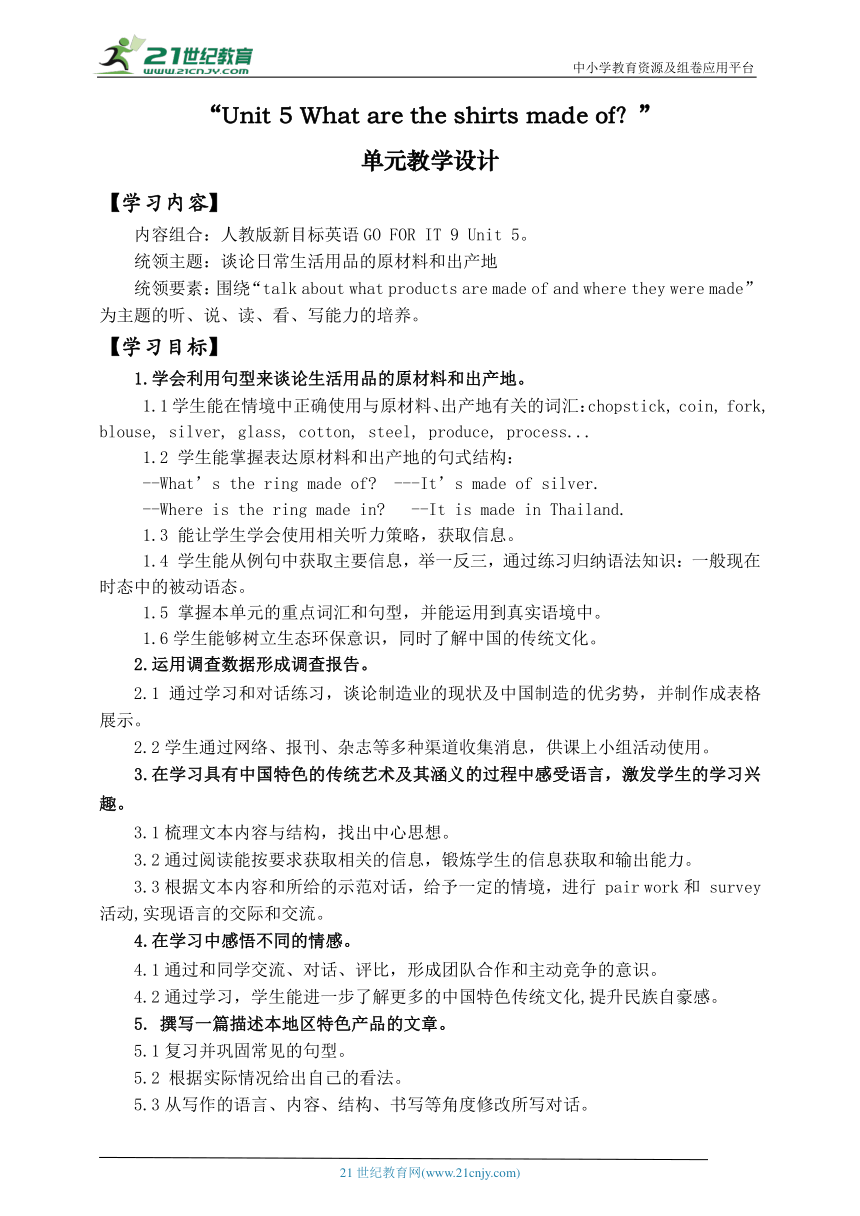 | |
| 格式 | docx | ||
| 文件大小 | 654.6KB | ||
| 资源类型 | 试卷 | ||
| 版本资源 | 人教新目标(Go for it)版 | ||
| 科目 | 英语 | ||
| 更新时间 | 2025-08-23 20:45:11 | ||
图片预览

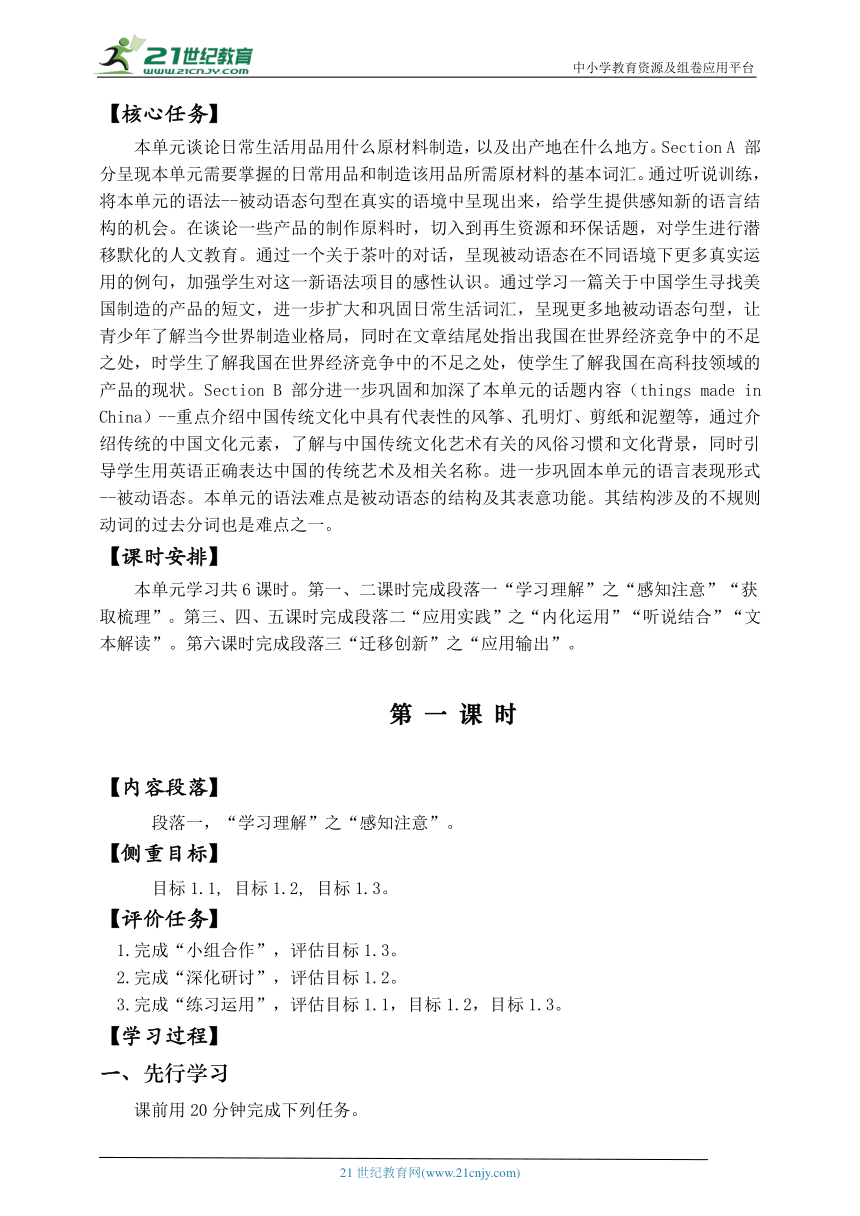
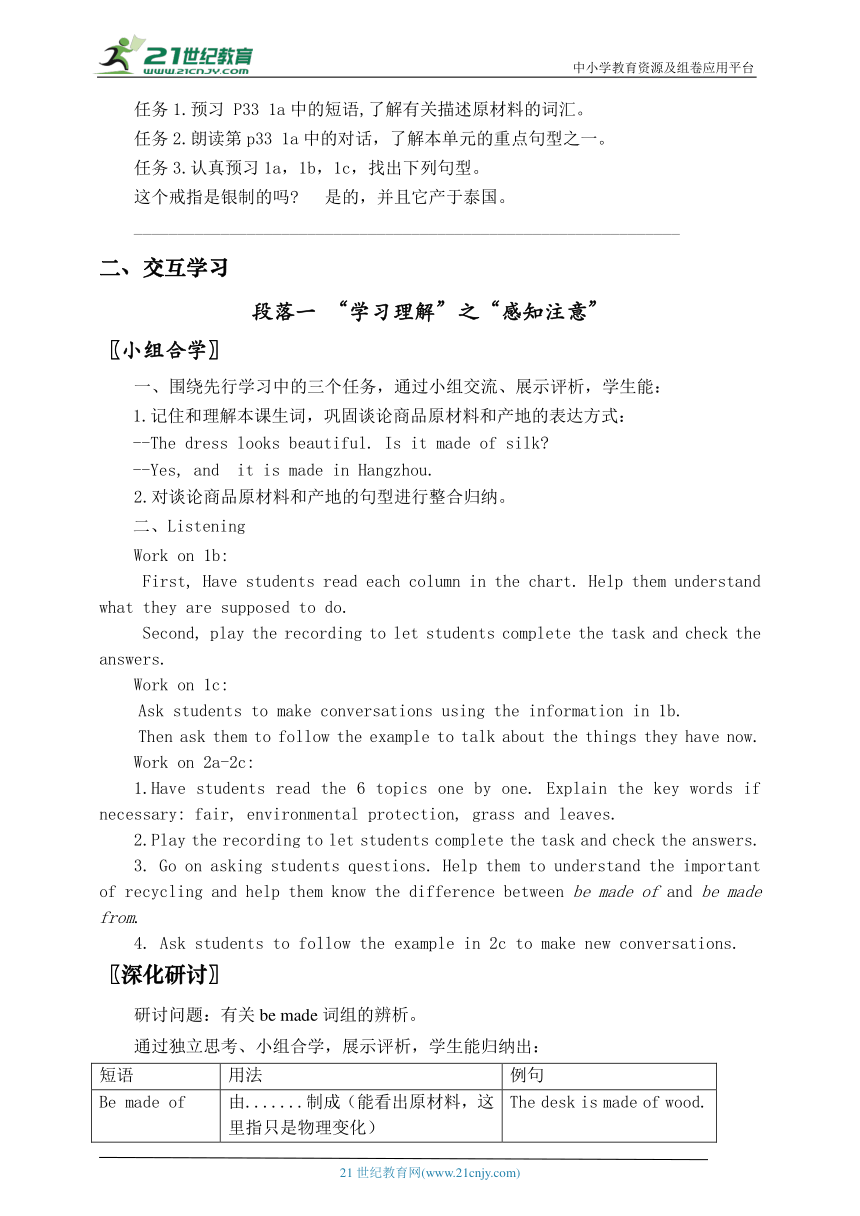
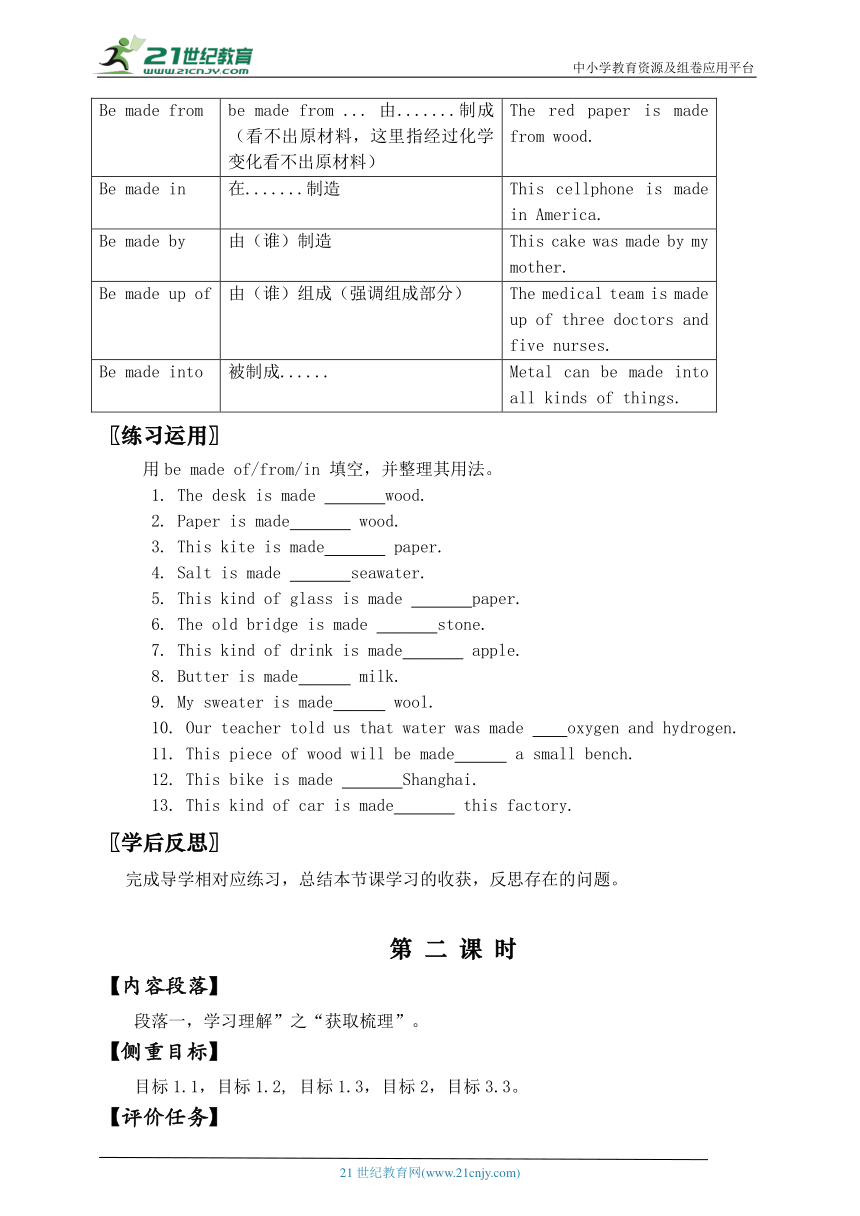
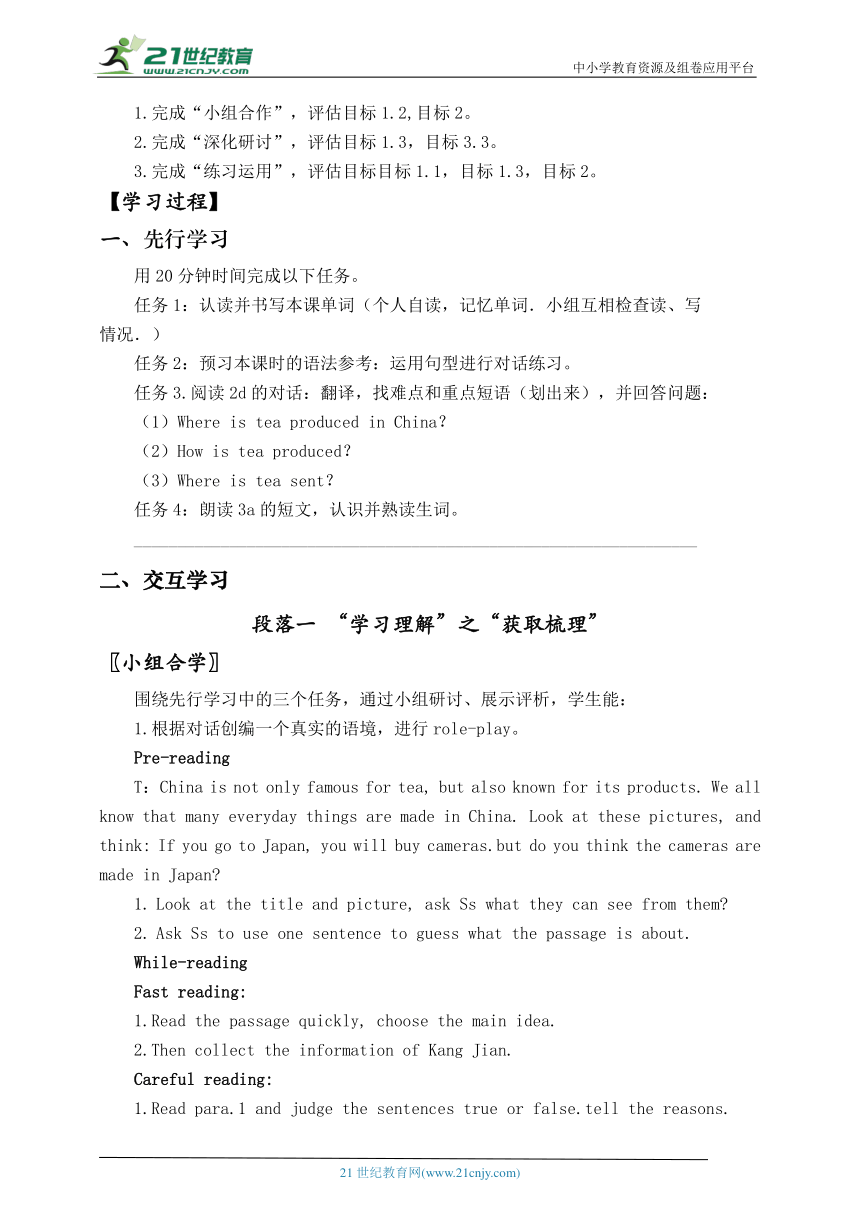
文档简介
中小学教育资源及组卷应用平台
“Unit 5 What are the shirts made of?”
单元教学设计
【学习内容】
内容组合:人教版新目标英语GO FOR IT 9 Unit 5。
统领主题:谈论日常生活用品的原材料和出产地
统领要素:围绕“talk about what products are made of and where they were made”为主题的听、说、读、看、写能力的培养。
【学习目标】
1.学会利用句型来谈论生活用品的原材料和出产地。
1.1学生能在情境中正确使用与原材料、出产地有关的词汇:chopstick, coin, fork, blouse, silver, glass, cotton, steel, produce, process...
1.2 学生能掌握表达原材料和出产地的句式结构:
--What’s the ring made of ---It’s made of silver.
--Where is the ring made in --It is made in Thailand.
1.3 能让学生学会使用相关听力策略,获取信息。
1.4 学生能从例句中获取主要信息,举一反三,通过练习归纳语法知识:一般现在时态中的被动语态。
1.5 掌握本单元的重点词汇和句型,并能运用到真实语境中。
1.6学生能够树立生态环保意识,同时了解中国的传统文化。
2.运用调查数据形成调查报告。
2.1通过学习和对话练习,谈论制造业的现状及中国制造的优劣势,并制作成表格展示。
2.2学生通过网络、报刊、杂志等多种渠道收集消息,供课上小组活动使用。
3.在学习具有中国特色的传统艺术及其涵义的过程中感受语言,激发学生的学习兴趣。
3.1梳理文本内容与结构,找出中心思想。
3.2通过阅读能按要求获取相关的信息,锻炼学生的信息获取和输出能力。
3.3根据文本内容和所给的示范对话,给予一定的情境,进行 pair work和 survey活动,实现语言的交际和交流。
4.在学习中感悟不同的情感。
4.1通过和同学交流、对话、评比,形成团队合作和主动竞争的意识。
4.2通过学习,学生能进一步了解更多的中国特色传统文化,提升民族自豪感。
撰写一篇描述本地区特色产品的文章。
5.1复习并巩固常见的句型。
5.2 根据实际情况给出自己的看法。
5.3从写作的语言、内容、结构、书写等角度修改所写对话。
【核心任务】
本单元谈论日常生活用品用什么原材料制造,以及出产地在什么地方。Section A 部分呈现本单元需要掌握的日常用品和制造该用品所需原材料的基本词汇。通过听说训练,将本单元的语法--被动语态句型在真实的语境中呈现出来,给学生提供感知新的语言结构的机会。在谈论一些产品的制作原料时,切入到再生资源和环保话题,对学生进行潜移默化的人文教育。通过一个关于茶叶的对话,呈现被动语态在不同语境下更多真实运用的例句,加强学生对这一新语法项目的感性认识。通过学习一篇关于中国学生寻找美国制造的产品的短文,进一步扩大和巩固日常生活词汇,呈现更多地被动语态句型,让青少年了解当今世界制造业格局,同时在文章结尾处指出我国在世界经济竞争中的不足之处,时学生了解我国在世界经济竞争中的不足之处,使学生了解我国在高科技领域的产品的现状。Section B部分进一步巩固和加深了本单元的话题内容(things made in China)--重点介绍中国传统文化中具有代表性的风筝、孔明灯、剪纸和泥塑等,通过介绍传统的中国文化元素,了解与中国传统文化艺术有关的风俗习惯和文化背景,同时引导学生用英语正确表达中国的传统艺术及相关名称。进一步巩固本单元的语言表现形式--被动语态。本单元的语法难点是被动语态的结构及其表意功能。其结构涉及的不规则动词的过去分词也是难点之一。
【课时安排】
本单元学习共6课时。第一、二课时完成段落一“学习理解”之“感知注意”“获取梳理”。第三、四、五课时完成段落二“应用实践”之“内化运用”“听说结合”“文本解读”。第六课时完成段落三“迁移创新”之“应用输出”。
第 一 课 时
【内容段落】
段落一,“学习理解”之“感知注意”。
【侧重目标】
目标1.1, 目标1.2, 目标1.3。
【评价任务】
1.完成“小组合作”,评估目标1.3。
2.完成“深化研讨”,评估目标1.2。
3.完成“练习运用”,评估目标1.1,目标1.2,目标1.3。
【学习过程】
一、先行学习
课前用20分钟完成下列任务。
任务1.预习 P33 1a中的短语,了解有关描述原材料的词汇。
任务2.朗读第p33 1a中的对话,了解本单元的重点句型之一。
任务3.认真预习1a,1b,1c,找出下列句型。
这个戒指是银制的吗 是的,并且它产于泰国。
_______________________________________________________________
二、交互学习
段落一 “学习理解”之“感知注意”
〖小组合学〗
一、围绕先行学习中的三个任务,通过小组交流、展示评析,学生能:
1.记住和理解本课生词,巩固谈论商品原材料和产地的表达方式:
--The dress looks beautiful. Is it made of silk
--Yes, and it is made in Hangzhou.
2.对谈论商品原材料和产地的句型进行整合归纳。
二、Listening
Work on 1b:
First, Have students read each column in the chart. Help them understand what they are supposed to do.
Second, play the recording to let students complete the task and check the answers.
Work on 1c:
Ask students to make conversations using the information in 1b.
Then ask them to follow the example to talk about the things they have now.
Work on 2a-2c:
1.Have students read the 6 topics one by one. Explain the key words if necessary: fair, environmental protection, grass and leaves.
2.Play the recording to let students complete the task and check the answers.
3. Go on asking students questions. Help them to understand the important of recycling and help them know the difference between be made of and be made from.
4. Ask students to follow the example in 2c to make new conversations.
〖深化研讨〗
研讨问题:有关be made词组的辨析。
通过独立思考、小组合学,展示评析,学生能归纳出:
短语 用法 例句
Be made of 由.......制成(能看出原材料,这里指只是物理变化) The desk is made of wood.
Be made from be made from ... 由.......制成(看不出原材料,这里指经过化学变化看不出原材料) The red paper is made from wood.
Be made in 在.......制造 This cellphone is made in America.
Be made by 由(谁)制造 This cake was made by my mother.
Be made up of 由(谁)组成(强调组成部分) The medical team is made up of three doctors and five nurses.
Be made into 被制成...... Metal can be made into all kinds of things.
〖练习运用〗
用be made of/from/in 填空,并整理其用法。
1. The desk is made wood.
2. Paper is made wood.
3. This kite is made paper.
4. Salt is made seawater.
5. This kind of glass is made paper.
6. The old bridge is made stone.
7. This kind of drink is made apple.
8. Butter is made milk.
9. My sweater is made wool.
10. Our teacher told us that water was made oxygen and hydrogen.
11. This piece of wood will be made a small bench.
12. This bike is made Shanghai.
13. This kind of car is made this factory.
〖学后反思〗
完成导学相对应练习,总结本节课学习的收获,反思存在的问题。
第 二 课 时
【内容段落】
段落一,学习理解”之“获取梳理”。
【侧重目标】
目标1.1,目标1.2, 目标1.3,目标2,目标3.3。
【评价任务】
1.完成“小组合作”,评估目标1.2,目标2。
2.完成“深化研讨”,评估目标1.3,目标3.3。
3.完成“练习运用”,评估目标目标1.1,目标1.3,目标2。
【学习过程】
一、先行学习
用20分钟时间完成以下任务。
任务1:认读并书写本课单词(个人自读,记忆单词.小组互相检查读、写
情况.)
任务2:预习本课时的语法参考:运用句型进行对话练习。
任务3.阅读2d的对话:翻译,找难点和重点短语(划出来),并回答问题:
(1)Where is tea produced in China?
(2)How is tea produced?
(3)Where is tea sent?
任务4:朗读3a的短文,认识并熟读生词。
_________________________________________________________________
二、交互学习
段落一 “学习理解”之“获取梳理”
〖小组合学〗
围绕先行学习中的三个任务,通过小组研讨、展示评析,学生能:
1.根据对话创编一个真实的语境,进行role-play。
Pre-reading
T:China is not only famous for tea, but also known for its products. We all know that many everyday things are made in China. Look at these pictures, and think: If you go to Japan, you will buy cameras.but do you think the cameras are made in Japan
Look at the title and picture, ask Ss what they can see from them
Ask Ss to use one sentence to guess what the passage is about.
While-reading
Fast reading:
1.Read the passage quickly, choose the main idea.
2.Then collect the information of Kang Jian.
Careful reading:
1.Read para.1 and judge the sentences true or false.tell the reasons.
Kang Jian went to the USA with his aunt and uncle. ( )
Many products in the local shops in the US were made in China.( )
Kang Jian can easily buy an American-made toy car in the US.( )
2.Read para.1 again,and find what the words in bold refer to.
(1)No matter what you may buy, you might think those products were made in those countries.
A.A watch B. some clothes and a watch
C.the products you buy in other countries
(2)No matter what you may buy, you might think those products were made in those countries.
A. Japan B. Japan and Switzerland C. the countries you visit
(3)He found it interesting that so many products in the local shops were made in China.
3.Read para.2 carefully and answer the questions.
(1)What other things did Kang Jian find were made in China
Key:Football, handbag, pet food, mobile phones. Even American flags are made in China.
(2)What does Kang Jian wish
Key: In the future, China will also get better at marking high-technology products that people can buy in all parts of the world.
4.Read the whole passage, and work on 3b.
Post-reading
1.Recite the passage by oneself.
2.Writing Time:If you have a chance to write a letter to President Xi,please tell something about Kang Jian’s trip and give your own opinion.
Dear _______,
My name is ____, I am ___ years old.
I have a good friend, he is Kang Jian. Last year he went to ___ to visit _____, he wanted to buy _____ and ______. but he found that most of the products are______.
After hearing his story, I feel ______, I think China will __________________.
As a middle school student, I will ___________________.
May you be healthy!
Yours,
...
〖深化研讨〗
研讨问题:有关be known for/as,be famous for/as等短语的辨析。
通过独立思考、小组合学,学生能归纳其语法特征:
结构 用法 例句
Be known as 意为“作为……而著名”,其后的名词表示一个人的身份、职业等。 Liu Huan is known as a singer.
Be known for 意为“因……而著名”,其后所接内容表示某人或物的特点、特长等。 Guilin is known for her beautiful mountains and rivers.
Be known to “为……所了解/知道”,其后接表示人的词语。“(人们都)知道”,其后接动词原形。 He is known to all in our village.
Be famous for/be famous as这一对短语都表示“以……而出(著名)”,但含义与用法有区别。
1、当主语是表示人的名词时,be famous for 表示“以某种知识、技能、作品或特征而出名”,而be famous as 则表示“以某种身份而出名”。
E.g.He is famous for his great inventions.
He is famous as a great inventor.
2、当主语是表示地点的名词时,be famous for 表示“以某种特点(产品)而出名”,be famous as 表示“以什么样的产地/地方而出名”。
France is famous for his fine food and wine.
The town is famous as a wine-producing place.
3、当主语是事物名词时,be famous for 表示“以其内容、特征、价值等而被人所知”,be famous as 表示“以某种形式出名”。
This grammar book is famous for its practical usage.
This book is famous as a conference book.
be famous to:对…来说是出名的。
The Great Wall is famous to the people all over the world.
The pop singer is famous to the young people.
〖练习运用〗
一、辨析be famous for, be famous as,be famous to.
1. He is famous his skill in playing football.
A. as B. for C. to D. in
2. The passage was famous the students.
A. as B. for C. to D. in
3. The area is famous its green tea.
A. as B. for C. to D. in
4. He is famous a great inventor.
A. as B. for C. to D. in
5. The town is famous a wine-producing place.
A. As B. for C. to D. in
〖学后反思〗
1.梳理和绘制学习本单元A部分的“talk about what products are made of and where they were made”话题思维导图。
2.完成导学作业,总结本节课的学习收获,反思学习中存在的问题。
第 三 课 时
【内容段落】
段落二,“应用实践”之“内化运用”。
【侧重目标】
目标1.2,目标1.3,目标2.2,目标3.2,目标3.3。
【评价任务】
1.完成“小组合作”,评估目标1.2,目标1.3,目标 3.2。
2.完成“深度研学”,评估目标3.3。
3.完成“练习运用”,评估目标2.2。
【学习过程】
先行学习
课前用20分钟时间独立完成以下任务。
任务1:熟读并识记本单元的重点词汇。
任务2. 阅读Grammar Focus,并找出规律。
______________________________________
任务3:复习动词过去式和过去分词的变化规则,注意不规则变化。
二、交互学习
段落二 “应用实践”之“内化运用”
〖小组合学〗
围绕先行学习中的三个任务,通过小组合学、展示评析,学生能:
1.Let Ss read the sentences below, paying attention to the underlined parts.
Is it made of silver
It was made in Thailand.
What is the model plane made of
Where is tea produced in China
How is it grown
It is planted on the side of mountains.
They are picked by hand and then are sent for processing.
explain the rule of passive voice.
主动语态转化为被动语态:
将主动句的宾语改成被动句的主语。
将主动句的谓语改成“be + 过去分词”
将主动句的主语改成by的宾语,放在谓语后(可以省略)
Many people speak English.
主语 谓语动词主动语态的现在式 宾语
English is spoken by many people.
主语 谓语动词被动语态的过去分词 介词+宾语
(设计意图:从例句中找出规律,同时推导出被动语态的句式结构,让学生对被动语态有个基础的印象,同时初步学习被动语态的用法。)
3.work on 4a-4c
Ask Ss to complete the sentences with the correct forms of the verbs in brackets in 4a.
Ask Ss to change the third and the fifth sentences into active voice, and ask Ss to tell the differences.
Ask Ss to rewrite the sentences in 4b using the passive voice.
T makes an example using a pencil. Then ask Ss to talk about something they are wearing or have in their schoolbags.
〖深化研讨〗
研讨问题:一般现在时态中被动语态的几种句型。
通过独立思考、小组合学,学生能归纳其语法特征:
1.肯定句:主语 + be + 过去分词 + (by...)
It’s made of used wood and glass.
2.否定句:主语 + be + not + 过去分词 + (by...)
They are not made in the USA.
3.一般疑问句: Be + 主语 + 过去分词 + (by...)
Are your shirt made of cotton
4.特殊疑问句: 特殊疑问词 + be + 主语 + 过去分词 + (by...)
What’s the coat made from
〖练习运用〗
一、用所给词的正确形式填空。
1.sunglasses ____ (use) for protecting people’s eyes.
2.A picture _____ (put) up on the blackboard.
3.French _____ (speak) in France.
4.Vegetables, eggs and fruits _____ (sell) in this shop.
二、按要求改写下列句子,一空一词。
1.Tea is grown in South China. (改为主动语态)
People _____ ______ in South China.
2.People use metal for making machines.(改为被动语态)
Metal ____ _____ _____ making machines.
3.They produce silk in Suzhou.(改为被动语态)
Silk _____ ______ in Suzhou.
〖学后反思〗
完成导学作业,总结本节课的学习收获,反思学习中存在的问题。
第 四 课 时
【内容段落】
段落二,“应用实践”之“听说结合”。
【侧重目标】
目标1,目标2。
【评价任务】
1.完成“小组合作”,评估目标1.6, 目标2.2,。
2.完成“练习运用”,评估目标2.1,目标2.2。
【学习过程】
一、先行学习
课前用20分钟时间独立完成以下任务:
任务1:参照预习单上的图片,认知单词及短语。
任务2:查找资料,了解关于风筝的一些情况。
二、交互学习
段落二 “应用实践”之“听说结合”
〖小组合学〗
围绕先行学习中的两个任务,通过小组合学、展示评析,学生能:
1.Listen to a conversation between Laura and Zheng Yun and circle the correct answers.
2.Listen and match.(L for Laura or Z for Zheng Yun.)
3.Listen again. Fill in the blanks with what you hear.
4.Group work: make a kite design poster in your group.
〖练习运用〗
一、句式转换。
1.Jim has finished the work.(改为被动语态)
________________________________
2.Most of the farm work is done by machine in the USA.(改为一般疑问句)
_________________________________________
3.French and English are spoken in Canada.(对划线部分提问)。
_____ ______ _______ _______ in Canada
用所给动词的正确形式填空。
Usually computers _____ (use) to get information on the Internet.
This watch ______ (make)in China.
Trees ______ (plant)in Spring.
The brown desk ______ (make)of wood.
〖学后反思〗
完成导学作业,总结本节课的学习收获,反思学习中存在的问题。
第 五 课 时
【内容段落】
段落二,“应用实践”之“文本解读”。
【侧重目标】
目标3.1,目标4。
【评价任务】
1.完成“小组合学”评估目标3.1,目标4。
2.完成“练习运用”评估目标4。
【学习过程】
一、先行学习
课前用20分钟时间独立完成以下任务:
任务1:个人自读,记忆本课单词,读后小组互相检查单词阅读情况;
任务2:阅读2b短文,以小组为单位,共同找出本课中的重点内容,然后在组内交流探讨。
任务3:任务3:创作剪纸作品。
任务4:Read and draw a mind-map about the context of the passage.
________________________________________________________________
交互学习
段落二 “应用实践”之“文本解读”
〖小组合学〗
围绕先行学习1-4任务,通过小组合学,展示评析,学生能:
1.掌握本单元的重点词汇。
2.能正确运用本单元的句型和表达句式,并能应用到实际情境中去。
Before reading
Ask Ss to divide the passage into several parts,and give the reason.
Fast reading
Read the passage and complete the chart.
Common things Objects of beauty symbols
Bamboo Sky lanterns Happiness and good wishes
Paper(usually red) Paper cutting Wishes for good luck and a happy new year
clay Chinese clay art Love for life and beauty
Careful reading
1.read para.1 and answer the question.
What do traditional Chinese art forms try to show
Key:They try to show the things are important in life, such as love, beauty and family.
2.read Para.2, and answer the questions. And then retell the second paragraph.
Who invented them What’s the symbol of lanterns
What do the lanterns How are they made
Rise into the air
What were they used to do in the past
and what are they used to do now
They _____ lit, they slowly _____ the air
Like hot-air ________.
In the past Now
They ______ used to They are used at
ask for _____ when ________ and other
in_______. ___________.
3.Show the paper cuttings made by Ss. Let Ss enjoy the beauty of Chinese traditional art.
4.then read the para.3 and tell T or F.
( )1.Paper cutting has been around for less than 1500 years.
( )2.The paper, usually red, is folded before it is cut with scissors.
( )3.The most common pictures are kids, plants,animals and things about Chinese history.
( )4.During the spring festival, paper cuttings are put on windows, doors as symbols of wishes for good luck and a happy new year.
Read para.4 and match: How can we make Chinese clay
Step 4 They’re fired at a very high heat.
Step 1 The pieces are carefully shaped.
Step 2 The pieces are allowed to air-dry.
Step 3 They are polished and painted.
Post reading
1.summary
2.Group work
Report: You are invited to introduce the Chinese traditional art to some visitors. Please choose one and prepare with your group members.
〖练习运用〗
完成思维导图并复述文章。
〖学后反思〗
通过自我评价,量化思考,学生能找出存在问题,调整学习策略。
第 六 课 时
【内容段落】
段落三,“迁移创新”之“应用输出”。
【侧重目标】
目标3.1,目标4。
【评价任务】
1.完成“小组合学”评估目标3.1,目标5。
2.完成“练习运用”评估目标5。
【学习过程】
一、先行学习
课前用20分钟时间独立完成以下任务:
任务1:复习本单元重点词汇或短语。
任务2:查阅资料,收集素材,为描述本地区特色产品做准备。
交互学习
段落三 “迁移创新”之“应用输出”
〖小组合学〗
Show some pictures about special things in our city, for example, green tea, clay art and so on.
Ask Ss to think of some other special things. Make a list.
point to the chart in 3a. ask Ss to use the questions in the
chart to discuss the special things.
Is it made of/ from wood/ paper/ gold/ silver/ cotton/ silk/ glass/ plastic/ steel
Where i it made
Try to What is it used fort
think about What is it used for
What is it known for
Why is it special
Write a paragraph about the product. Use your notes in 3a.
Use the following expressions to help you:
My town/city is famous for…
…is famous in my town/ city.
…is / are made of / from / with/ by / in…
…is / are used for…
…is / are known for…
…is / are special because…
5.【写作任务】
假如你叫李华, 来自江西省景德镇市。近日,你的加拿大笔友Marcus发来一封电子邮件,他说要来你市旅游,询问你市以什么而闻名,并让你推荐有什么值得赠送朋友的纪念品。请你根据下面的要点提示给他回复邮件。
要点提示:
1.以瓷器(china)闻名及其意义;
2.原材料:陶土;
3.用途:可供人们欣赏、也可用来装(contain)东西;
4.最佳推荐:青花瓷(blue and white porcelain)。
6.Show the article of Ss, and polish it together.
Dear Marcus,
How are you doing these days I’m excited to hear from you. I’d like to introduce something special in my city to you.
My city, Jingdezhen in Jiangxi Province, is famous for its china. China is special because it is an example of exquisite Chinese craftsmanship and it is a symbol of traditional Chinese culture. It is made from clay. It is made to be enjoyed by people. And it is used for containing things. Many things are made of china in our everyday life, such as cups, bowls and plates. Every day many different kinds of china are produced here. Blue and white porcelain is the most famous one. It is known to people around the world. You can buy some for your friends and relatives.
Welcome to my city! I hope you will have a good time here!
Best wishes!
Yours,
Li Hua
〖练习运用〗
1.Self check 1, 2,3.
2.Write a article about the special things in Hangzhou.
三、后续学习
1.进行第五单元的检测。
21世纪教育网 www.21cnjy.com 精品试卷·第 2 页 (共 2 页)
21世纪教育网(www.21cnjy.com)
“Unit 5 What are the shirts made of?”
单元教学设计
【学习内容】
内容组合:人教版新目标英语GO FOR IT 9 Unit 5。
统领主题:谈论日常生活用品的原材料和出产地
统领要素:围绕“talk about what products are made of and where they were made”为主题的听、说、读、看、写能力的培养。
【学习目标】
1.学会利用句型来谈论生活用品的原材料和出产地。
1.1学生能在情境中正确使用与原材料、出产地有关的词汇:chopstick, coin, fork, blouse, silver, glass, cotton, steel, produce, process...
1.2 学生能掌握表达原材料和出产地的句式结构:
--What’s the ring made of ---It’s made of silver.
--Where is the ring made in --It is made in Thailand.
1.3 能让学生学会使用相关听力策略,获取信息。
1.4 学生能从例句中获取主要信息,举一反三,通过练习归纳语法知识:一般现在时态中的被动语态。
1.5 掌握本单元的重点词汇和句型,并能运用到真实语境中。
1.6学生能够树立生态环保意识,同时了解中国的传统文化。
2.运用调查数据形成调查报告。
2.1通过学习和对话练习,谈论制造业的现状及中国制造的优劣势,并制作成表格展示。
2.2学生通过网络、报刊、杂志等多种渠道收集消息,供课上小组活动使用。
3.在学习具有中国特色的传统艺术及其涵义的过程中感受语言,激发学生的学习兴趣。
3.1梳理文本内容与结构,找出中心思想。
3.2通过阅读能按要求获取相关的信息,锻炼学生的信息获取和输出能力。
3.3根据文本内容和所给的示范对话,给予一定的情境,进行 pair work和 survey活动,实现语言的交际和交流。
4.在学习中感悟不同的情感。
4.1通过和同学交流、对话、评比,形成团队合作和主动竞争的意识。
4.2通过学习,学生能进一步了解更多的中国特色传统文化,提升民族自豪感。
撰写一篇描述本地区特色产品的文章。
5.1复习并巩固常见的句型。
5.2 根据实际情况给出自己的看法。
5.3从写作的语言、内容、结构、书写等角度修改所写对话。
【核心任务】
本单元谈论日常生活用品用什么原材料制造,以及出产地在什么地方。Section A 部分呈现本单元需要掌握的日常用品和制造该用品所需原材料的基本词汇。通过听说训练,将本单元的语法--被动语态句型在真实的语境中呈现出来,给学生提供感知新的语言结构的机会。在谈论一些产品的制作原料时,切入到再生资源和环保话题,对学生进行潜移默化的人文教育。通过一个关于茶叶的对话,呈现被动语态在不同语境下更多真实运用的例句,加强学生对这一新语法项目的感性认识。通过学习一篇关于中国学生寻找美国制造的产品的短文,进一步扩大和巩固日常生活词汇,呈现更多地被动语态句型,让青少年了解当今世界制造业格局,同时在文章结尾处指出我国在世界经济竞争中的不足之处,时学生了解我国在世界经济竞争中的不足之处,使学生了解我国在高科技领域的产品的现状。Section B部分进一步巩固和加深了本单元的话题内容(things made in China)--重点介绍中国传统文化中具有代表性的风筝、孔明灯、剪纸和泥塑等,通过介绍传统的中国文化元素,了解与中国传统文化艺术有关的风俗习惯和文化背景,同时引导学生用英语正确表达中国的传统艺术及相关名称。进一步巩固本单元的语言表现形式--被动语态。本单元的语法难点是被动语态的结构及其表意功能。其结构涉及的不规则动词的过去分词也是难点之一。
【课时安排】
本单元学习共6课时。第一、二课时完成段落一“学习理解”之“感知注意”“获取梳理”。第三、四、五课时完成段落二“应用实践”之“内化运用”“听说结合”“文本解读”。第六课时完成段落三“迁移创新”之“应用输出”。
第 一 课 时
【内容段落】
段落一,“学习理解”之“感知注意”。
【侧重目标】
目标1.1, 目标1.2, 目标1.3。
【评价任务】
1.完成“小组合作”,评估目标1.3。
2.完成“深化研讨”,评估目标1.2。
3.完成“练习运用”,评估目标1.1,目标1.2,目标1.3。
【学习过程】
一、先行学习
课前用20分钟完成下列任务。
任务1.预习 P33 1a中的短语,了解有关描述原材料的词汇。
任务2.朗读第p33 1a中的对话,了解本单元的重点句型之一。
任务3.认真预习1a,1b,1c,找出下列句型。
这个戒指是银制的吗 是的,并且它产于泰国。
_______________________________________________________________
二、交互学习
段落一 “学习理解”之“感知注意”
〖小组合学〗
一、围绕先行学习中的三个任务,通过小组交流、展示评析,学生能:
1.记住和理解本课生词,巩固谈论商品原材料和产地的表达方式:
--The dress looks beautiful. Is it made of silk
--Yes, and it is made in Hangzhou.
2.对谈论商品原材料和产地的句型进行整合归纳。
二、Listening
Work on 1b:
First, Have students read each column in the chart. Help them understand what they are supposed to do.
Second, play the recording to let students complete the task and check the answers.
Work on 1c:
Ask students to make conversations using the information in 1b.
Then ask them to follow the example to talk about the things they have now.
Work on 2a-2c:
1.Have students read the 6 topics one by one. Explain the key words if necessary: fair, environmental protection, grass and leaves.
2.Play the recording to let students complete the task and check the answers.
3. Go on asking students questions. Help them to understand the important of recycling and help them know the difference between be made of and be made from.
4. Ask students to follow the example in 2c to make new conversations.
〖深化研讨〗
研讨问题:有关be made词组的辨析。
通过独立思考、小组合学,展示评析,学生能归纳出:
短语 用法 例句
Be made of 由.......制成(能看出原材料,这里指只是物理变化) The desk is made of wood.
Be made from be made from ... 由.......制成(看不出原材料,这里指经过化学变化看不出原材料) The red paper is made from wood.
Be made in 在.......制造 This cellphone is made in America.
Be made by 由(谁)制造 This cake was made by my mother.
Be made up of 由(谁)组成(强调组成部分) The medical team is made up of three doctors and five nurses.
Be made into 被制成...... Metal can be made into all kinds of things.
〖练习运用〗
用be made of/from/in 填空,并整理其用法。
1. The desk is made wood.
2. Paper is made wood.
3. This kite is made paper.
4. Salt is made seawater.
5. This kind of glass is made paper.
6. The old bridge is made stone.
7. This kind of drink is made apple.
8. Butter is made milk.
9. My sweater is made wool.
10. Our teacher told us that water was made oxygen and hydrogen.
11. This piece of wood will be made a small bench.
12. This bike is made Shanghai.
13. This kind of car is made this factory.
〖学后反思〗
完成导学相对应练习,总结本节课学习的收获,反思存在的问题。
第 二 课 时
【内容段落】
段落一,学习理解”之“获取梳理”。
【侧重目标】
目标1.1,目标1.2, 目标1.3,目标2,目标3.3。
【评价任务】
1.完成“小组合作”,评估目标1.2,目标2。
2.完成“深化研讨”,评估目标1.3,目标3.3。
3.完成“练习运用”,评估目标目标1.1,目标1.3,目标2。
【学习过程】
一、先行学习
用20分钟时间完成以下任务。
任务1:认读并书写本课单词(个人自读,记忆单词.小组互相检查读、写
情况.)
任务2:预习本课时的语法参考:运用句型进行对话练习。
任务3.阅读2d的对话:翻译,找难点和重点短语(划出来),并回答问题:
(1)Where is tea produced in China?
(2)How is tea produced?
(3)Where is tea sent?
任务4:朗读3a的短文,认识并熟读生词。
_________________________________________________________________
二、交互学习
段落一 “学习理解”之“获取梳理”
〖小组合学〗
围绕先行学习中的三个任务,通过小组研讨、展示评析,学生能:
1.根据对话创编一个真实的语境,进行role-play。
Pre-reading
T:China is not only famous for tea, but also known for its products. We all know that many everyday things are made in China. Look at these pictures, and think: If you go to Japan, you will buy cameras.but do you think the cameras are made in Japan
Look at the title and picture, ask Ss what they can see from them
Ask Ss to use one sentence to guess what the passage is about.
While-reading
Fast reading:
1.Read the passage quickly, choose the main idea.
2.Then collect the information of Kang Jian.
Careful reading:
1.Read para.1 and judge the sentences true or false.tell the reasons.
Kang Jian went to the USA with his aunt and uncle. ( )
Many products in the local shops in the US were made in China.( )
Kang Jian can easily buy an American-made toy car in the US.( )
2.Read para.1 again,and find what the words in bold refer to.
(1)No matter what you may buy, you might think those products were made in those countries.
A.A watch B. some clothes and a watch
C.the products you buy in other countries
(2)No matter what you may buy, you might think those products were made in those countries.
A. Japan B. Japan and Switzerland C. the countries you visit
(3)He found it interesting that so many products in the local shops were made in China.
3.Read para.2 carefully and answer the questions.
(1)What other things did Kang Jian find were made in China
Key:Football, handbag, pet food, mobile phones. Even American flags are made in China.
(2)What does Kang Jian wish
Key: In the future, China will also get better at marking high-technology products that people can buy in all parts of the world.
4.Read the whole passage, and work on 3b.
Post-reading
1.Recite the passage by oneself.
2.Writing Time:If you have a chance to write a letter to President Xi,please tell something about Kang Jian’s trip and give your own opinion.
Dear _______,
My name is ____, I am ___ years old.
I have a good friend, he is Kang Jian. Last year he went to ___ to visit _____, he wanted to buy _____ and ______. but he found that most of the products are______.
After hearing his story, I feel ______, I think China will __________________.
As a middle school student, I will ___________________.
May you be healthy!
Yours,
...
〖深化研讨〗
研讨问题:有关be known for/as,be famous for/as等短语的辨析。
通过独立思考、小组合学,学生能归纳其语法特征:
结构 用法 例句
Be known as 意为“作为……而著名”,其后的名词表示一个人的身份、职业等。 Liu Huan is known as a singer.
Be known for 意为“因……而著名”,其后所接内容表示某人或物的特点、特长等。 Guilin is known for her beautiful mountains and rivers.
Be known to “为……所了解/知道”,其后接表示人的词语。“(人们都)知道”,其后接动词原形。 He is known to all in our village.
Be famous for/be famous as这一对短语都表示“以……而出(著名)”,但含义与用法有区别。
1、当主语是表示人的名词时,be famous for 表示“以某种知识、技能、作品或特征而出名”,而be famous as 则表示“以某种身份而出名”。
E.g.He is famous for his great inventions.
He is famous as a great inventor.
2、当主语是表示地点的名词时,be famous for 表示“以某种特点(产品)而出名”,be famous as 表示“以什么样的产地/地方而出名”。
France is famous for his fine food and wine.
The town is famous as a wine-producing place.
3、当主语是事物名词时,be famous for 表示“以其内容、特征、价值等而被人所知”,be famous as 表示“以某种形式出名”。
This grammar book is famous for its practical usage.
This book is famous as a conference book.
be famous to:对…来说是出名的。
The Great Wall is famous to the people all over the world.
The pop singer is famous to the young people.
〖练习运用〗
一、辨析be famous for, be famous as,be famous to.
1. He is famous his skill in playing football.
A. as B. for C. to D. in
2. The passage was famous the students.
A. as B. for C. to D. in
3. The area is famous its green tea.
A. as B. for C. to D. in
4. He is famous a great inventor.
A. as B. for C. to D. in
5. The town is famous a wine-producing place.
A. As B. for C. to D. in
〖学后反思〗
1.梳理和绘制学习本单元A部分的“talk about what products are made of and where they were made”话题思维导图。
2.完成导学作业,总结本节课的学习收获,反思学习中存在的问题。
第 三 课 时
【内容段落】
段落二,“应用实践”之“内化运用”。
【侧重目标】
目标1.2,目标1.3,目标2.2,目标3.2,目标3.3。
【评价任务】
1.完成“小组合作”,评估目标1.2,目标1.3,目标 3.2。
2.完成“深度研学”,评估目标3.3。
3.完成“练习运用”,评估目标2.2。
【学习过程】
先行学习
课前用20分钟时间独立完成以下任务。
任务1:熟读并识记本单元的重点词汇。
任务2. 阅读Grammar Focus,并找出规律。
______________________________________
任务3:复习动词过去式和过去分词的变化规则,注意不规则变化。
二、交互学习
段落二 “应用实践”之“内化运用”
〖小组合学〗
围绕先行学习中的三个任务,通过小组合学、展示评析,学生能:
1.Let Ss read the sentences below, paying attention to the underlined parts.
Is it made of silver
It was made in Thailand.
What is the model plane made of
Where is tea produced in China
How is it grown
It is planted on the side of mountains.
They are picked by hand and then are sent for processing.
explain the rule of passive voice.
主动语态转化为被动语态:
将主动句的宾语改成被动句的主语。
将主动句的谓语改成“be + 过去分词”
将主动句的主语改成by的宾语,放在谓语后(可以省略)
Many people speak English.
主语 谓语动词主动语态的现在式 宾语
English is spoken by many people.
主语 谓语动词被动语态的过去分词 介词+宾语
(设计意图:从例句中找出规律,同时推导出被动语态的句式结构,让学生对被动语态有个基础的印象,同时初步学习被动语态的用法。)
3.work on 4a-4c
Ask Ss to complete the sentences with the correct forms of the verbs in brackets in 4a.
Ask Ss to change the third and the fifth sentences into active voice, and ask Ss to tell the differences.
Ask Ss to rewrite the sentences in 4b using the passive voice.
T makes an example using a pencil. Then ask Ss to talk about something they are wearing or have in their schoolbags.
〖深化研讨〗
研讨问题:一般现在时态中被动语态的几种句型。
通过独立思考、小组合学,学生能归纳其语法特征:
1.肯定句:主语 + be + 过去分词 + (by...)
It’s made of used wood and glass.
2.否定句:主语 + be + not + 过去分词 + (by...)
They are not made in the USA.
3.一般疑问句: Be + 主语 + 过去分词 + (by...)
Are your shirt made of cotton
4.特殊疑问句: 特殊疑问词 + be + 主语 + 过去分词 + (by...)
What’s the coat made from
〖练习运用〗
一、用所给词的正确形式填空。
1.sunglasses ____ (use) for protecting people’s eyes.
2.A picture _____ (put) up on the blackboard.
3.French _____ (speak) in France.
4.Vegetables, eggs and fruits _____ (sell) in this shop.
二、按要求改写下列句子,一空一词。
1.Tea is grown in South China. (改为主动语态)
People _____ ______ in South China.
2.People use metal for making machines.(改为被动语态)
Metal ____ _____ _____ making machines.
3.They produce silk in Suzhou.(改为被动语态)
Silk _____ ______ in Suzhou.
〖学后反思〗
完成导学作业,总结本节课的学习收获,反思学习中存在的问题。
第 四 课 时
【内容段落】
段落二,“应用实践”之“听说结合”。
【侧重目标】
目标1,目标2。
【评价任务】
1.完成“小组合作”,评估目标1.6, 目标2.2,。
2.完成“练习运用”,评估目标2.1,目标2.2。
【学习过程】
一、先行学习
课前用20分钟时间独立完成以下任务:
任务1:参照预习单上的图片,认知单词及短语。
任务2:查找资料,了解关于风筝的一些情况。
二、交互学习
段落二 “应用实践”之“听说结合”
〖小组合学〗
围绕先行学习中的两个任务,通过小组合学、展示评析,学生能:
1.Listen to a conversation between Laura and Zheng Yun and circle the correct answers.
2.Listen and match.(L for Laura or Z for Zheng Yun.)
3.Listen again. Fill in the blanks with what you hear.
4.Group work: make a kite design poster in your group.
〖练习运用〗
一、句式转换。
1.Jim has finished the work.(改为被动语态)
________________________________
2.Most of the farm work is done by machine in the USA.(改为一般疑问句)
_________________________________________
3.French and English are spoken in Canada.(对划线部分提问)。
_____ ______ _______ _______ in Canada
用所给动词的正确形式填空。
Usually computers _____ (use) to get information on the Internet.
This watch ______ (make)in China.
Trees ______ (plant)in Spring.
The brown desk ______ (make)of wood.
〖学后反思〗
完成导学作业,总结本节课的学习收获,反思学习中存在的问题。
第 五 课 时
【内容段落】
段落二,“应用实践”之“文本解读”。
【侧重目标】
目标3.1,目标4。
【评价任务】
1.完成“小组合学”评估目标3.1,目标4。
2.完成“练习运用”评估目标4。
【学习过程】
一、先行学习
课前用20分钟时间独立完成以下任务:
任务1:个人自读,记忆本课单词,读后小组互相检查单词阅读情况;
任务2:阅读2b短文,以小组为单位,共同找出本课中的重点内容,然后在组内交流探讨。
任务3:任务3:创作剪纸作品。
任务4:Read and draw a mind-map about the context of the passage.
________________________________________________________________
交互学习
段落二 “应用实践”之“文本解读”
〖小组合学〗
围绕先行学习1-4任务,通过小组合学,展示评析,学生能:
1.掌握本单元的重点词汇。
2.能正确运用本单元的句型和表达句式,并能应用到实际情境中去。
Before reading
Ask Ss to divide the passage into several parts,and give the reason.
Fast reading
Read the passage and complete the chart.
Common things Objects of beauty symbols
Bamboo Sky lanterns Happiness and good wishes
Paper(usually red) Paper cutting Wishes for good luck and a happy new year
clay Chinese clay art Love for life and beauty
Careful reading
1.read para.1 and answer the question.
What do traditional Chinese art forms try to show
Key:They try to show the things are important in life, such as love, beauty and family.
2.read Para.2, and answer the questions. And then retell the second paragraph.
Who invented them What’s the symbol of lanterns
What do the lanterns How are they made
Rise into the air
What were they used to do in the past
and what are they used to do now
They _____ lit, they slowly _____ the air
Like hot-air ________.
In the past Now
They ______ used to They are used at
ask for _____ when ________ and other
in_______. ___________.
3.Show the paper cuttings made by Ss. Let Ss enjoy the beauty of Chinese traditional art.
4.then read the para.3 and tell T or F.
( )1.Paper cutting has been around for less than 1500 years.
( )2.The paper, usually red, is folded before it is cut with scissors.
( )3.The most common pictures are kids, plants,animals and things about Chinese history.
( )4.During the spring festival, paper cuttings are put on windows, doors as symbols of wishes for good luck and a happy new year.
Read para.4 and match: How can we make Chinese clay
Step 4 They’re fired at a very high heat.
Step 1 The pieces are carefully shaped.
Step 2 The pieces are allowed to air-dry.
Step 3 They are polished and painted.
Post reading
1.summary
2.Group work
Report: You are invited to introduce the Chinese traditional art to some visitors. Please choose one and prepare with your group members.
〖练习运用〗
完成思维导图并复述文章。
〖学后反思〗
通过自我评价,量化思考,学生能找出存在问题,调整学习策略。
第 六 课 时
【内容段落】
段落三,“迁移创新”之“应用输出”。
【侧重目标】
目标3.1,目标4。
【评价任务】
1.完成“小组合学”评估目标3.1,目标5。
2.完成“练习运用”评估目标5。
【学习过程】
一、先行学习
课前用20分钟时间独立完成以下任务:
任务1:复习本单元重点词汇或短语。
任务2:查阅资料,收集素材,为描述本地区特色产品做准备。
交互学习
段落三 “迁移创新”之“应用输出”
〖小组合学〗
Show some pictures about special things in our city, for example, green tea, clay art and so on.
Ask Ss to think of some other special things. Make a list.
point to the chart in 3a. ask Ss to use the questions in the
chart to discuss the special things.
Is it made of/ from wood/ paper/ gold/ silver/ cotton/ silk/ glass/ plastic/ steel
Where i it made
Try to What is it used fort
think about What is it used for
What is it known for
Why is it special
Write a paragraph about the product. Use your notes in 3a.
Use the following expressions to help you:
My town/city is famous for…
…is famous in my town/ city.
…is / are made of / from / with/ by / in…
…is / are used for…
…is / are known for…
…is / are special because…
5.【写作任务】
假如你叫李华, 来自江西省景德镇市。近日,你的加拿大笔友Marcus发来一封电子邮件,他说要来你市旅游,询问你市以什么而闻名,并让你推荐有什么值得赠送朋友的纪念品。请你根据下面的要点提示给他回复邮件。
要点提示:
1.以瓷器(china)闻名及其意义;
2.原材料:陶土;
3.用途:可供人们欣赏、也可用来装(contain)东西;
4.最佳推荐:青花瓷(blue and white porcelain)。
6.Show the article of Ss, and polish it together.
Dear Marcus,
How are you doing these days I’m excited to hear from you. I’d like to introduce something special in my city to you.
My city, Jingdezhen in Jiangxi Province, is famous for its china. China is special because it is an example of exquisite Chinese craftsmanship and it is a symbol of traditional Chinese culture. It is made from clay. It is made to be enjoyed by people. And it is used for containing things. Many things are made of china in our everyday life, such as cups, bowls and plates. Every day many different kinds of china are produced here. Blue and white porcelain is the most famous one. It is known to people around the world. You can buy some for your friends and relatives.
Welcome to my city! I hope you will have a good time here!
Best wishes!
Yours,
Li Hua
〖练习运用〗
1.Self check 1, 2,3.
2.Write a article about the special things in Hangzhou.
三、后续学习
1.进行第五单元的检测。
21世纪教育网 www.21cnjy.com 精品试卷·第 2 页 (共 2 页)
21世纪教育网(www.21cnjy.com)
同课章节目录
- Unit 1 How can we become good learners.
- Section A
- Section B
- Unit 2 I think that mooncakes are delicious!
- Section A
- Section B
- Unit 3 Could you please tell me where the restroom
- Section A
- Section B
- Unit 4 I used to be afraid of the dark.
- Section A
- Section B
- Unit 5 What are the shirts made of?
- Section A
- Section B
- Review of Units 1-5
- Unit 6 When was it invented?
- Section A
- Section B
- Unit 7 Teenagers should be allowed to choose their
- Section A
- Section B
- Unit 8 It must belong to Carla.
- Section A
- Section B
- Unit 9 I like music that I can dance to.
- Section A
- Section B
- Unit 10 You're supposed to shake hands.
- Section A
- Section B
- Review of Units 6-10
- Unit 11 Sad movies make me cry.
- Section A
- Section B
- Unit 12 Life is full of the unexpected
- Section A
- Section B
- Unit 13 We're trying to save the earth!
- Section A
- Section B
- Unit 14 I remember meeting all of you in Grade 7.
- Section A
- Section B
- Review of Units 11-14
